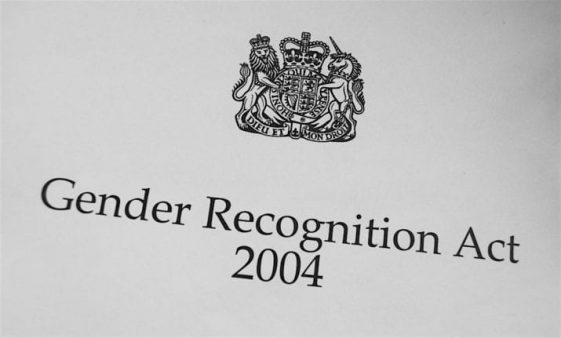On “Choosing Reality”: How Public Discussions of Gender Recognition Go Wrong, and What We Can Do About It: Part 1 Arguing About What Gender Really Is
7 February 2022
Content advice: transphobia.
On 10th October 2018, a full page-advert ran in the Metro, London’s free commuter newspaper. The topic of the advert was an imminently closing government consultation on the Gender Recognition Act 2004, the legislation governing changes of legal gender for trans people in England and Wales. The government was considering adopting a simplified system in which trans people would be able to change the gender on their birth certificate by means of a statutory declaration alone, in contrast to the existing process which was expensive, bureaucratic, and inaccessible to many trans people. This proposal was strongly supported by trans rights campaigners and LGBT charities.
The advert was run by a group called ‘Fair Play For Women’, and aimed to encourage people to respond to the consultation with a negative assessment of the proposal, on the grounds that the reform would be bad for women and girls. The advert posed questions such as, ‘Do you think fully intact, male-bodied prisoners should be allowed to live with women in prison?’, and, ‘Do you think someone with a penis is a woman?’. Most of the page was taken up with large text reading: ‘Think about it. #ChooseReality’.
The advert, with its alarmist tone and prurient focus on trans women’s bodies, was entirely in keeping with much of the anti-reform discourse around the consultation. What happened next, though, was very interesting.
The clear implication of the slogan ‘choose reality’ in the context of the advert was that trans women (or at least those trans women who have not had genital surgery) are not really women, and that for this reason they ought not to be treated as women socially and politically.
However, the hashtag was quickly picked up on social media by people in favour of reform who turned it on its head to argue that trans people were indeed ‘choosing reality’ by choosing to live in accordance with their gender identity – something that the proposed legislation would make much easier. One tweet stated, ‘When a person transitions and becomes their authentic self rather than live a lie that is them deciding to #choosereality.’ Another tweet read, ‘#ChooseReality and choose to fight for women’s rights, because trans women #really are women and trans women’s rights #really are women’s rights’.
This pushback highlights something very important, which is that arguments like this rest on a distorted picture of the realities of trans people’s lives. In this sense, it provides an incisive critique of the claims made in the advert.
However, it is noticeable that this way of pushing back at the advert does not challenge an assumption that the slogan ‘Choose Reality’ implicitly rests upon, which is that the dispute about gender recognition should be settled by establishing what gender really is. On this way of thinking, if trans women are “really men”, they should be treated as men, and if they are “really women”, they should be treated as women.
This is the approach to settling disagreements about gender recognition that I am going to focus on in this series of blog posts. I will call it the ‘Ontology-First Approach’, since it puts ontological questions (which is to say, questions about what exists) ahead of questions about how we should arrange our social practices.
What is more, it does this in a way that assumes that our answers to the first set of questions will determine our answers to the second: if we know what gender really is, the thought goes, we will also automatically know how to respond to people on the basis of gender in our social lives.
It’s worth noticing that the social practices in question here go well beyond the legislation of the Gender Recognition Act: the advert mentions sports, changing rooms, and domestic violence refuges, none of which would have been affected by the proposed reforms. So in the sense I have in mind, ‘gender recognition’ is not just about legislation, but is about all of the provisions, formal and informal, for how people should be able to navigate gendered social spaces (like toilets) and take part in gendered social activities (like sports).
I think the Ontology First Approach is quite common in public discussions of gender recognition. Here is another example. In 2017 the broadcaster Jenni Murray, then presenter of BBC Radio 4 show Woman’s Hour, wrote a widely discussed opinion piece that was published in The Sunday Times. The piece was headlined ‘Be trans, be proud – but don’t call yourself a “real woman”’, and the subheading read: ‘Can someone who has lived as a man, with all the privilege that entails, really lay claim to womanhood? It takes more than a sex change and make-up’.
Murray wrote:
[M]y concern, which I know is shared by numerous women who are now to be known as “cis” (short for “cisgender” — natural-born women, in the language that’s more familiar to most of us), is for the impact this question of what constitutes “a real woman” will have on sexual politics. And for who has the right to be included in gatherings or organisations that are defined as single sex. (Murray 2017)
Here, Murray presents a question – ‘what constitutes “a real woman”’? – and the structure of her remarks imply that the way in which this question is settled will have impacts on people’s rights concerning the organisation of gendered social spaces (‘gatherings and organisations’). Thus, establishing what makes someone “a real woman” is treated as prior to and as determining questions of gender recognition.
As with the Fair Play for Women advert, some of the most prominent pushback against Murray’s piece focused on challenging the claim that trans women are not “real women” whilst appearing to grant that settling this question is important in the ways Murray presents it as being. For example, Rachel Stein, campaigns director of Stonewall, wrote a blog post titled ‘Trans Women Are Women’ in which she responded to Murray:
Trans women have every right to have their identity and experiences respected, too. They are women – just like you and me – and their sense of their gender is as engrained in their identity as yours or mine. (Stein 2017).
I take the Ontology-First Approach to be widely held by participants in discussions about gender recognition, including by those who support trans-inclusive social practices, as we have seen in both of these examples. I think, however, that this approach is unjustified, and in the next post, I’ll make the case for rejecting it.
- July 2024
- June 2024
- May 2024
- April 2024
- March 2024
- February 2024
- January 2024
- December 2023
- November 2023
- October 2023
- September 2023
- August 2023
- July 2023
- June 2023
- May 2023
- April 2023
- March 2023
- February 2023
- January 2023
- December 2022
- November 2022
- October 2022
- September 2022
- August 2022
- July 2022
- June 2022
- May 2022
- April 2022
- March 2022
- February 2022
- January 2022
- December 2021
- November 2021
- October 2021
- September 2021
- August 2021
- July 2021
- June 2021
- May 2021
- April 2021
- March 2021
- February 2021
- January 2021
- December 2020
- November 2020
- October 2020
- September 2020
- August 2020
- July 2020
- June 2020
- May 2020
- April 2020
- March 2020
- February 2020
- January 2020
- December 2019
- November 2019
- October 2019
- September 2019
- August 2019
- July 2019
- June 2019
- May 2019
- April 2019
- March 2019
- February 2019
- January 2019
- December 2018
- November 2018
- October 2018
- September 2018
- August 2018
- July 2018
- June 2018
- May 2018
- April 2018
- March 2018
- February 2018
- January 2018
- December 2017
- November 2017
- October 2017
- September 2017
- August 2017
- July 2017
- June 2017
- May 2017

